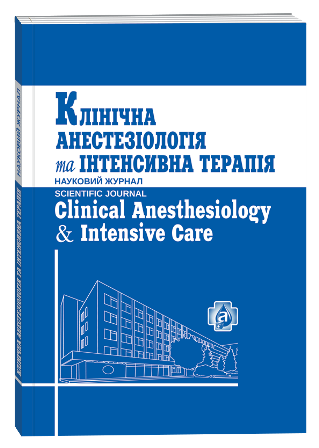THE INFLUENCE OF EPIDURAL ANALGESIA ON HEMOSTATIC POTENTIAL AFTER ABDOMINAL OPERATIONS IN PATIENTS WITH OBESITY
DOI:
https://doi.org/10.31379/2411.2616.11.1.3Keywords:
obesity, laparoscopic surgery, hemostasis, epidural analgesiaAbstract
Introduction. Current recommendations for the prevention of venous thromboembolism (VTE) in obese patients have a low level of evidence. That’s why the use of other techniques of influence on hemostatic potential (GP) is actual. Aim. To evaluate the effect of epidural analgesia (EA) on hemostatic system parameters after laparoscopic operations in obese patients. Material and methods. GP parameters were measured in 52 patients with BMI>30 kg/m2 using the method of low-frequency piezoelectric thromboelastography (LPTEG). The initial GP level was determined and its changes were compared on the 3rd day after surgery between the group of total intravenous anesthesia (TBA, n=26) and EA-group (n=25). Statistical analysis was conducted using Statistica for Windows version 6.0. Results. The initial level of GP didn’t differ significantly between the study groups. In TBA-group hypercoagulation and inhibition of fibrinolysis with a moderate decrease in platelet aggregation were present on the 3rd day after surgery (p<0.05). In EA-group there was an improvement in coagulation and fibrinolysis but aggregation rates reached the lower limit of the norm (p<0.05). Conclusion. Perioperative use of EA in abdominal laparoscopic surgery of patients with obesity helps to normalize coagulation and fibrinolytic GP components and reduces the aggregation of formed blood elements.
References
Stein P. D., Beemath A., Olson R. E. Obesity as a risk factor in venous thromboembolism. Am J Med. 2005. Vol. 118. P. 978–980.
Freeman A. L., Pendleton R. C., Rondina M. T. Prevention of venous thromboembolism in obesity. Expert Rev Cardiovasc Ther. 2010. Vol. 8, № 12. P. 1711–1721.
Incidence of venous thromboembolism after bariatric surgery: a population-based cohort study / D. A. Froehling et al. Obes Surg. 2013. Vol. 23. P. 1874–1879.
The long-term risk of venous thromboembolism following bariatric surgery / K. E. Steele et al. Obes Surg. 2011. Vol. 21. P. 1371–1376.
Thromboembolic events in bariatric surgery: a large multiinstitutional referral center experience / M. H. Jamal et al. Surg Endosc. 2015. Vol. 29. P. 376–380.
Perioperative rates of deep vein thrombosis and pulmonary embolism in normal weight vs obese and morbidly obese surgical patients in the era post venous thromboembolism prophylaxis guidelines / L. Wang et al. Am J Surg. 2015. Vol. 210. P. 859–863.
Caprini J. A. Thrombosis risk assessment as a guide to quality patient care. Dis Mon. 2005. Vol. 51. P. 70–78.
Venclauskas L., Maleckas A., Arcelus J. I. European guidelines on perioperative venous thromboembolism prophylaxis. Surgery in the obese patient. Eur J Anaesthesiol. 2018. Vol. 35. P. 147–153.
Clinical Practice Guidelines for Enhanced Recovery After Colon and Rectal Surgery From the American Society of Colon and Rectal Surgeons and Society of American Gastrointestinal and Endoscopic Surgeons / J. C. Carmichael et al. Dis Colon Rectum. 2017. Vol. 60. P. 761–784.
Guidelines for Perioperative Care in Bariatric Surgery: Enhanced Recovery After Surgery (ERAS) Society Recommendations / A. Thorell et al. World J Surg. 2016. Vol. 40. P. 2065–2083.
Systemic coagulation and fibrinolysis after laparoscopic and open gastriс bypass / N. T. Nguyen et al. Arch Surg. 2001. Vol. 136. P. 909–916.
Kehlet H., Holte K. Effect of postoperative analgesia on surgical outcome. British Journal of Anaesthesia. 2001. Vol. 87, № 1. P. 62–72.
Liu S., Wu C. Effect of postoperative analgesia on major postoperative complications: A systemic update of the evidence. Anesthesia & Analgesia. 2007. Vol. 104, № 3. P. 689–702.
Effects of Epidural Anesthesia and Analgesia on Coagulation and Outcome After Major Vascular Surgery / K. J. Tuman et al. Anesth Analg. 1991. Vol. 73. P. 696–704.
Pre- to postoperative coagulation profile of 307 patients undergoing oesophageal resection with epidural blockade over a 10-year period in a single hospital: implications for the risk of spinal haematoma / O. Thomas et al. Perioperative Medicine. 2017. Vol. 6. P. 14. doi 10.1186/s13741-017-0070-7.
Vorotyntsev S., Grytcenko S., Grynovska M. Multimodal Anesthesia/Analgesia Model in Obese Patients Undergoing Open Abdominal Surgery. GSL J Anesth Open Access. 2017. Vol. 1. P. 101. http://gslpublishers.org/journals/current-issue.php?title=gsl-journal-of-anesthesiology-openaccess. 17. Применение нового метода исследования функционального состояния системы гемостаза в клинической практике / И. И. Тютрин и др. Український журнал екстремальної медицини імені Г. О. Можаєва. 2010. Т. 11, № 4. С. 156–160.
Тютрин И. И., Удут В. В. Низкочастотная пьезотромбоэластография цельной крови: алгоритмы диагностики и коррекции гемостазиологических расстройств. Томск: Издательский Дом Томского государственного университета, 2016. 170 с.
Effects of epidural-and-general anesthesia combined versus general anesthesia alone on the venous hemodynamics of the lower limb. A randomized study / K. T. Delis et al. Thromb Haemost. 2004. Vol. 92, № 5. P. 1003–1011.
Epidural anesthesia prevents hypercoagulation in patients undergoing major orthopedic surgery / M. W. Hollmann et al. Reg Anesth Pain Med. 2001. Vol. 26, № 3. P. 215–222.
Modig J. Influence of regional anesthesia, local anesthetics, and sympathicomimetics on the pathophysiology of deep vein thrombosis. Acta Chir Scand. 1989. Vol. 550. P. 119–124.
Postoperative hypercoagulability and deep-vein thrombosis after laparoscopic cholecystectomy / J. A. Caprini et al. Surg Endosc. 1995. Vol. 9. P. 304–309.







